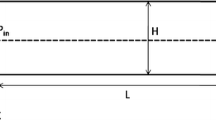Abstract
The dynamics of two-phase flows with a constant driving force inside a micro-channel is studied by using the Lattice Boltzmann Method (LBM) and the Shan-Chen multiphase model in this article. Flow regimes under different wall wettabilities and over smooth and grooved geometric surfaces are investigated. It is found that flow behaviors are strongly affected by the wall wettability and topography. Our results show that the LBM is efficient and accurate, and has very good application prospect in the study of drag reduction of microscopic seepage of reservoir.
Similar content being viewed by others
References
DI Qin-feng, SHEN Chen and WANG Zhang-hong et al. Experimental research on drag reduction of flow in micro-channels of rocks using nano-particle adsorption method[J]. Acta Petrolei Sinica, 2009, 30(1): 125–128.(in Chinese).
HYVALUOMA J., RAISKINMAKI P. and JASBERG A. et al. Simulation of liquid penetration in paper[J]. Physical Review E, 2006, 73(3): 036705–1.036705-8.
SHI Zi-yuan, YAN Yong-hua and YANG Fan et al. A lattice Boltzmann method for simulation of a three-dimensional drop impact on a liquid film[J]. Journal of Hydrodynamics, 2008, 20(3): 267–272.
Van DAM D. B., LE CLERC C. Experimental study of the impact of an ink-jet printed droplet on a solid substrate[J]. Physics of Fluids, 2004, 16(9): 3403–3414.
GUO Jia-hong, DAI Shi-qiang. Research on stability of liquid film on hot solid surface impinged by small droplets[J]. Journal of Hydrodynamics, Ser. B, 2007, 19(3): 264–271.
DUPUIS A., YEOMANS J. M. Modeling droplets on superhydrophobic surfaces: Equilibrium states and transitions[J]. Langmuir, 2005, 21(6): 2624–2629.
KIM L. S., JEONG H. K. and HA M. Y. et al. Numerical simulation of droplet formation in a micro-channel using the lattice Boltzmann method[J]. Journal of Mechanical Science and Technology, 2008, 22(4): 770–779.
CHEN S., DOOLEN G. D. Lattice Boltzmann method for fluid flows[J]. Annual Review of Fluid Mechanics, 1998, 30(1): 329–364.
AIDUN C. K., CLAUSEN J. R. Lattice Boltzmann method for complex flows[J]. Annual Review of Fluid Mechanics, 42(1): 439–472.
SHAN Xiao-wen, CHEN Hu-dong. Lattice Boltzmann model for simulating flows with multiple phases and components[J]. Physical Review E, 1993, 47(3): 1815–1819.
SHAN Xiao-wen and CHEN Hu-dong. Simulation of nonideal gases and liquid-gas phase transitions by the lattice Boltzmann equation[J]. Physical Review E, 1994, 49(4): 2941–2948.
QIAN Yue-hong, HUMIERES D. D’. and LALLEMAND P. Lattice BGK models for Navier-Stokes equation[J]. Europhysics Letters, 1992, 17(6): 479–484.
HUANG Haibo, THORNE D. T. Jr and SCHAAP M. G. et al. Proposed approximation for contact angles in Shan-and-Chen-type multicomponent multiphase lattice Boltzmann models[J]. Physical Review E, 2007, 76(6): 066701–1.066701-6.
BENZI R., BIFERALE L. and SBRAGAGLIA M. et al. Mesoscopic modeling of a two-phase flow in the presence of boundaries: The contact angle[J]. Physical Review E, 2006, 74(2): 1509–1.1509-14.
SHAN X. W. Analysis and reduction of the spurious current in a class of multiphase lattice Boltzmann models[J]. Physical Review E, 2006, 73(4): 7701–1.7701-4.
YUAN P., SCHAEFER L. Equations of state in a lattice Boltzmann model[J]. Physics of Fluids, 2006, 18(4): 42101–1.42101-11.
QIAN Yue-hong, SUCCI S. and ORSZAG S. A. Recent advances in lattice Boltzmann computing[J]. Ann. Rev. comp. Phys., 1995, (3): 195–242.
SUKOP M. C. Lattice Boltzmann modeling: an introduction for geoscientists and engineers[M]. 2006, Berlin: Springer.
YIN Dai-yin, PU Hui. Numerical simulation study on surfactant flooding for low permeability oilfield in the condition of threshold pressure[J]. Journal of Hydrodynamics, 2008, 20(4): 492–498.
GU Chun-yuan, DI Qin-feng and SHI Li-yi et al. Experimental investigation of superhydrophobic properties of the surface constructed by nanoparticles[J]. Acta Physica Sinica, 2008, 57(5): 3071–3076.in Chinese).
Author information
Authors and Affiliations
Corresponding author
Additional information
Project supported by the National Natural Science Foundation of China (Grant No. 50874071), the National High Technology Research and Development Program of China (863 Program, Grant No. 2008AA06Z201), the Program of Science and Technology Commission of Shanghai Municipality (Grant No. 071605102), the project of Shanghai Education Commission Research Innovation (Grand No. 08ZZ45), the Program for Changjiang Scholars and Innovative Research Team in Universities (Grant No. IRT0844), and the China Postdoctoral Science Foundation (Grant No. 20090450687).
Biography: ZHANG Ren-liang (1982-), Male, Ph. D. Candidate
Rights and permissions
About this article
Cite this article
Zhang, Rl., Di, Qf., Wang, Xl. et al. Numerical Study of Wall Wettabilities and Topography on Drag Reduction Effect in Micro-Channel Flow by Lattice Boltzmann Method. J Hydrodyn 22, 366–372 (2010). https://doi.org/10.1016/S1001-6058(09)60066-4
Received:
Revised:
Published:
Issue Date:
DOI: https://doi.org/10.1016/S1001-6058(09)60066-4




